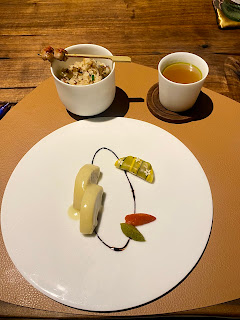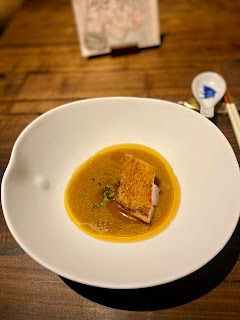Labyrinth and a discussion on what is Singapore cuisine.
This was easily the best meal I ate in Singapore and one that I enjoyed more than the more famous Odette or Les Amis. I was looking for a tasting menu that was rooted in Singapore and this really delivered.
 |
| Eggnog with cold coffee foam |
It’s hard to say what exactly Singapore cuisine is. What we call Singapore cuisine is really a collection of different ethnic communities and their cuisines. Hainanese. Peranakan. Malay. Teochew. Tamil. Singapore is a wonderful melting pot of different communities but when you eat their food you have to wonder if that’s just a collection of different ethnic cuisines with some local flourishes or is there something new? A reimagination that creates a common thread that defines Singapore cuisine.
 |
| Bak Kut Teh Consommé: pepper trio, tangerine peal, black winter truffle |
In some ways, Labyrinth is the restaurant that comes closest to feeling like a representation of Singapore food as a whole. It takes inspiration from the hawker centres and different communities but also from dying recipes and lost memories to create a menu that’s a celebration of Singapore cuisine. All this in a way that is playful and creative, that pays tribute without being bound by the source of inspiration.
 |
| Roti boy/ seaweed butter |
Labyrinth has been around for 11 years now and has always done well. But it’s only in the last few years that it has really popped and become significant rather than just successful. I feel a lot of that has to do with Chef Han really feeling unconstrained. He’s not trying to fit into food trends like in his early years influenced by the whole El Bulli wave. He’s also not trying to faithfully recreate traditional dishes in canonical form. Almost 60 years into the country’s existence, he’s creating Singapore food that is rooted in its present, and that looks forward rather than to the past.
 |
| Oyster bao: David Berve oyster, lions head mushroom |
 |
| Ramly burger: Tomato meringue, beef tartare |
He takes the famous Fuzhou Oyster Pancake at Maxwell but presents it like a bao with none of the greasy oiliness of the original. Or he takes Malaysian Ramly burgers but recreates it with a rich beef tartare.
 |
| Char Kway Teow: South Africa abalone, fish maw, homemade oyster sauce |
All the while he pushes flavour to the limit, coming close to the edge of balance but never stepping across the line. His take on Char Kway Teow is made with abalone noodles and fish maw and a homemade oyster sauce. But what makes it memorable is the use of yum cheong sausages, made with pork and duck liver, far more intense than lap cheong, as well as crispy pork lard. Theoretically, it feels like too many conflicting elements, but what you get instead is a dish with complexity and layers of complementary flavours.
 |
| Satay club: 2 cuts Iberico pork, chicken tsukune |
His sweet potato lemak is also deceptively complex. Purple sweet potatoes with crispy skin, buttery soft and sweet inside, but contrasted with the funky dried shrimp and lifted by the hum of dried chilli. Even his satay dish beats the hell out of any street satay. The pork satay had a fatty depth and the chicken has a hint of smoke. And it was served with Karre Karre, a Filipino sauce with Bago (fermented shrimp and pork), peanuts and toasted rice.
 |
| Chicken rice: Donabe, local French poulet, achar “taco”, gingko |
Maybe it’s because he’s not a trained chef but a former banker (at age 39, he reminds me of a young, Asian Bruno Verjus). But Han keeps making surprising choices that somehow come together beautifully. His chicken rice comes with donabe, and the Japanese clay pot rice doesn’t just retain the flavours of the broth but adds a textural layer. And I loved how he uses the crown of the chicken rather than throwing it away.
 |
| Cereal prawn: 2 ages of shaoxing, salted egg foam, oatmeal ice cream |
My favourite dish however was the dessert. Unlike many places, this wasn’t an afterthought but as considered as the savoury dishes that came before. The oatmeal ice cream with 2 kinds of aged shaoxing wine and salted egg is perfection itself. The oatmeal ice cream is a delicate and subtle thing, and we all know how salted egg has the ability to dominate all other flavours. Somehow Han manages to not just find balance but let the flavours complement and enhance each other. This is a beautiful and memorable dish, one of my favourite desserts of the year.
 |
| Laksa Siglap: kinki, Laksam noodles, urap |
This iteration of Labyrinth feels like it has something new and exciting to say about Asian food. Like Den and Wing, it feels brave, it challenges orthodoxies and it has fun. I know there are more famous restaurants in Singapore and ones with more Michelin stars. I’ve eaten at most of than and I would recommend Labyrinth over them all. In fact I would go as far as to say this is the most interesting and tasty fine dining meal I have had in Singapore since Andre Cheung left the city.







Comments